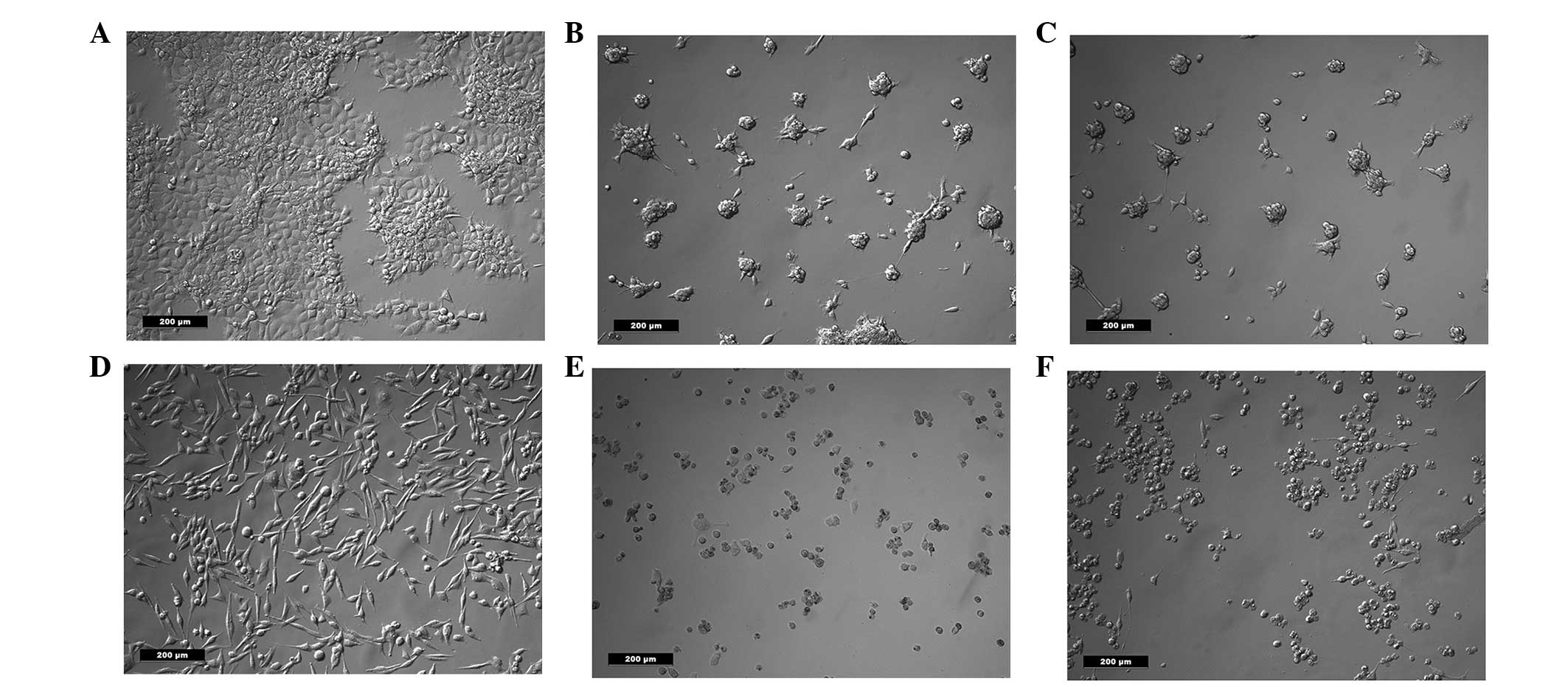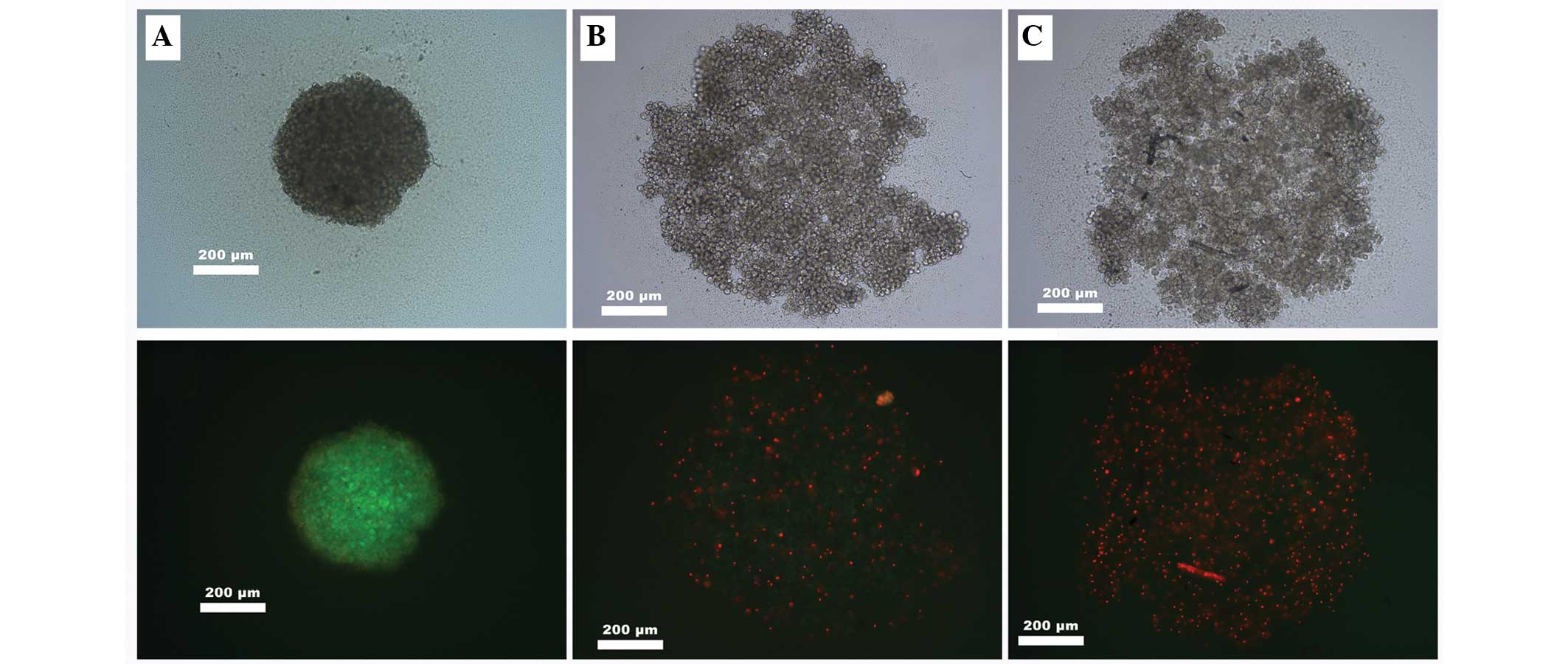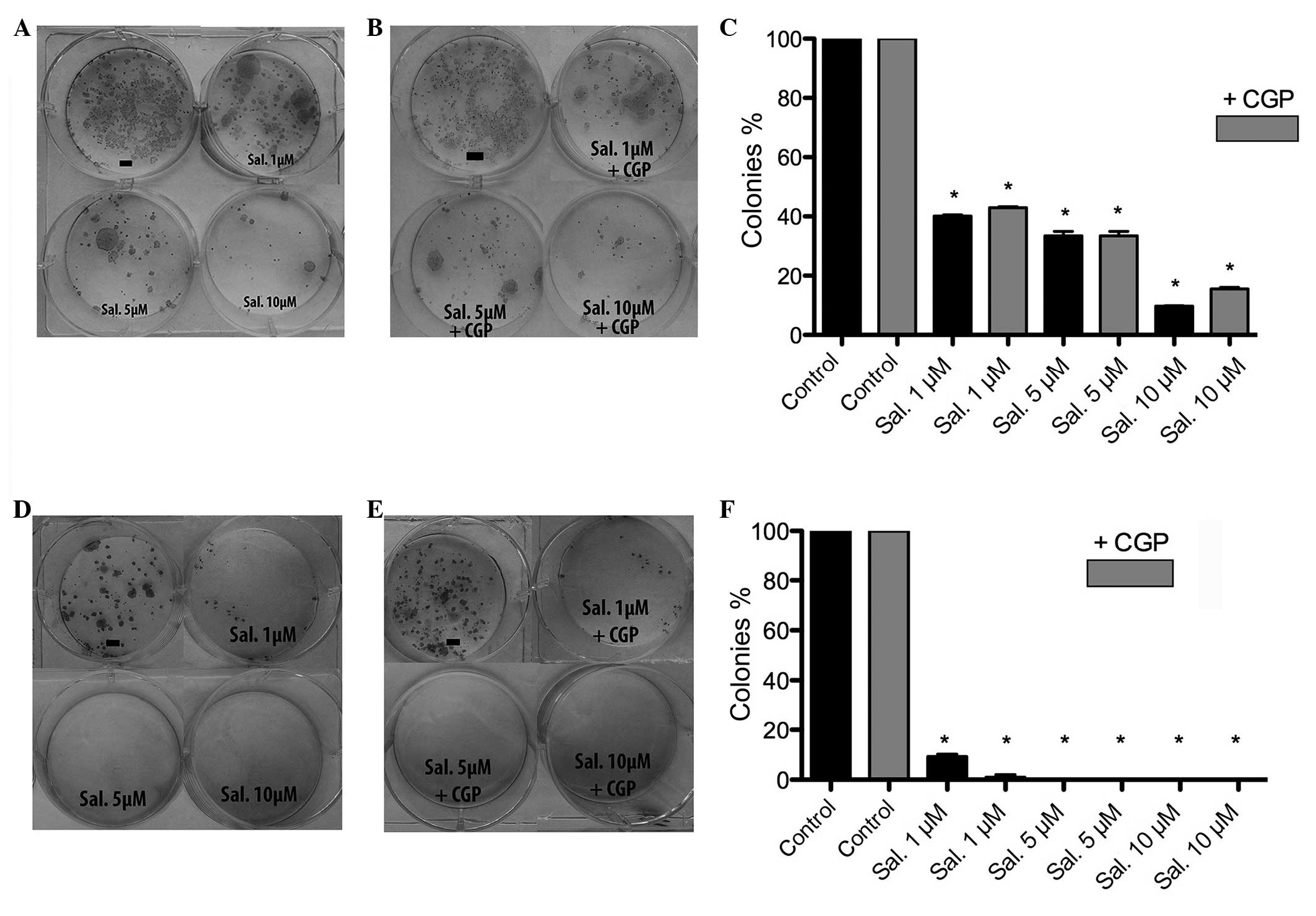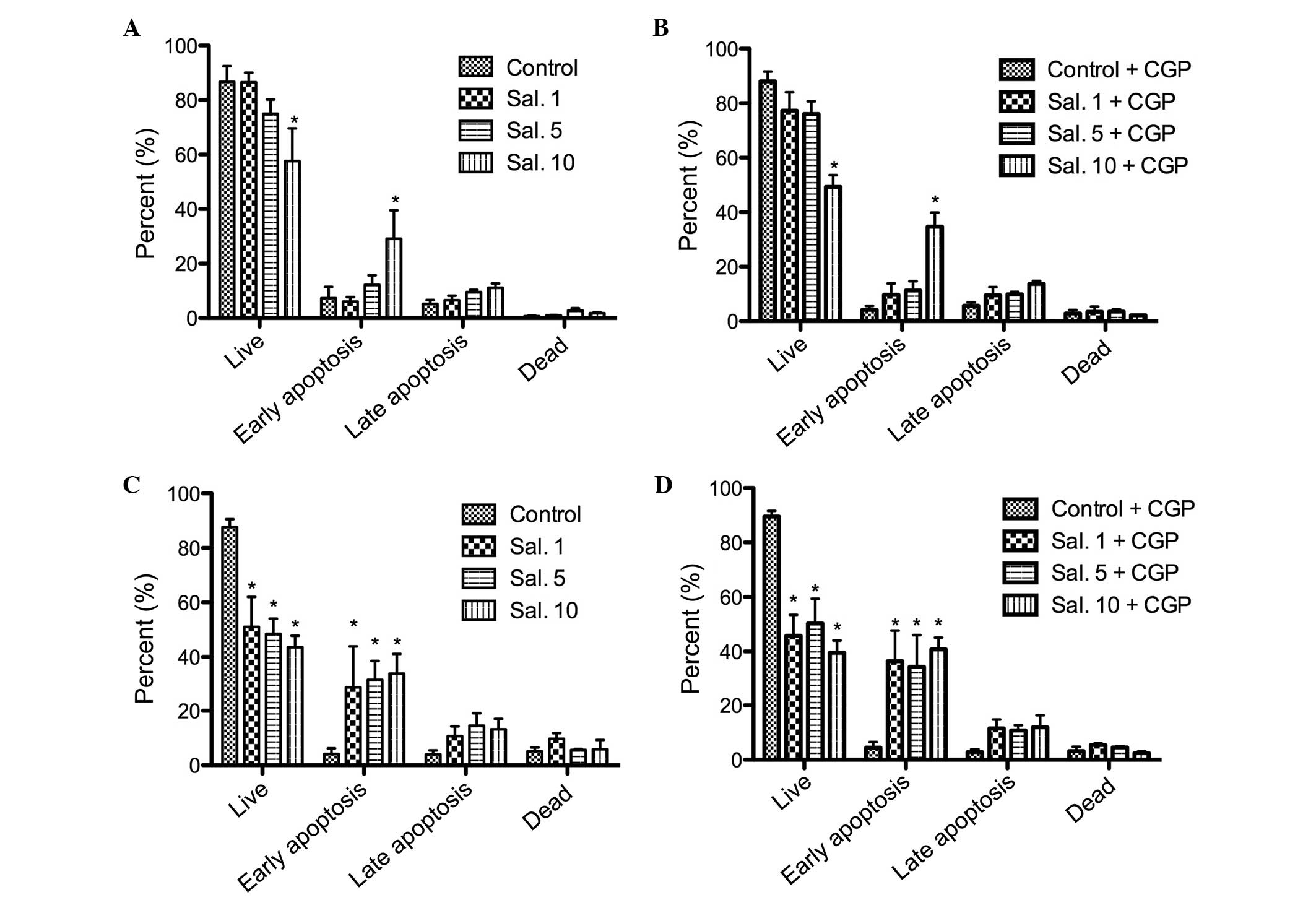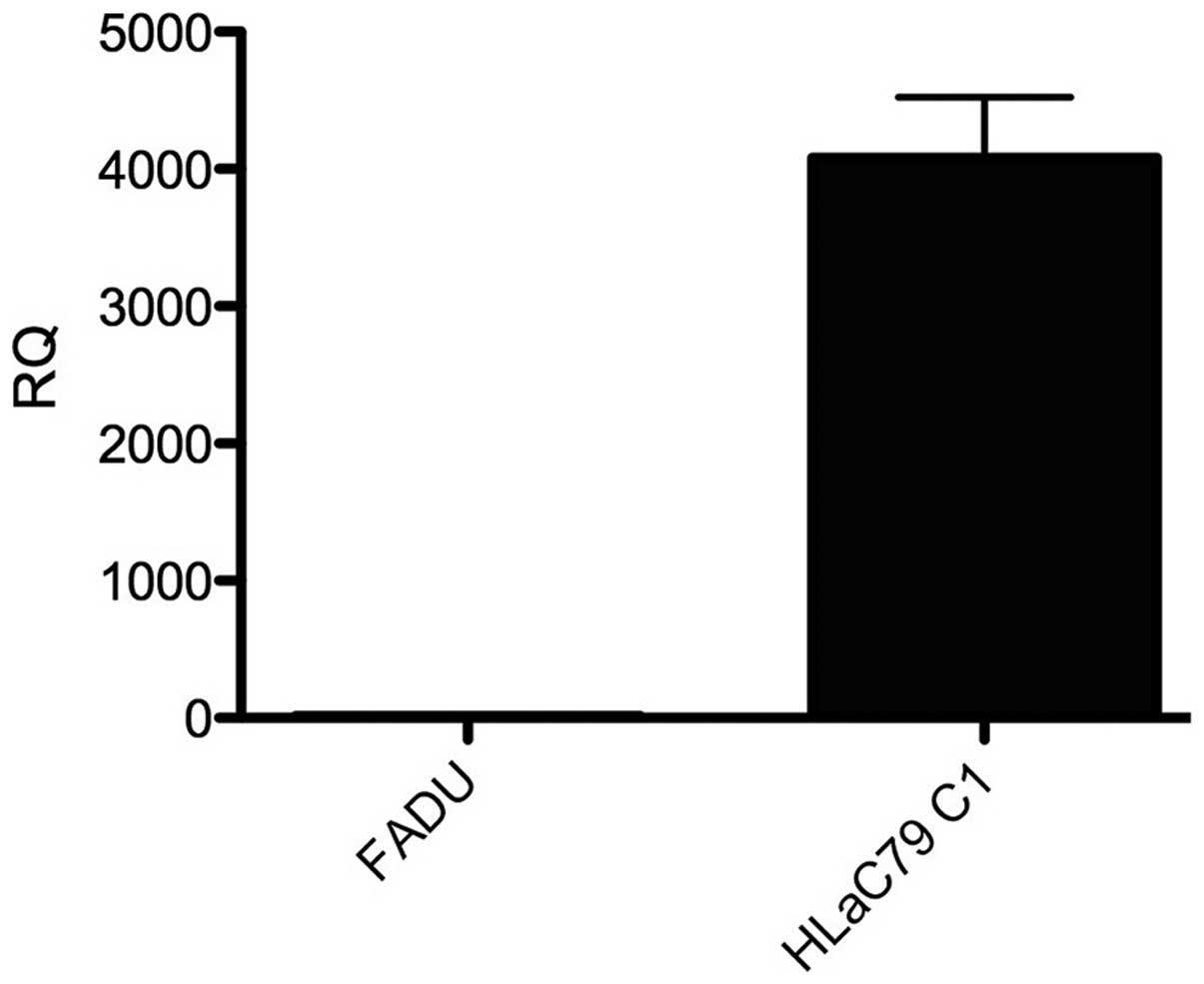Effects of salinomycin and CGP37157 on head and neck squamous cell carcinoma cell lines in vitro
- Authors:
- Published online on: June 22, 2015 https://doi.org/10.3892/mmr.2015.3981
- Pages: 4455-4461
Abstract
Introduction
In total, ~500,000 new cases of head and neck squamous cell carcinoma (HNSCC) are diagnosed annually worldwide (1). The majority of these patients suffer from locally advanced stage disease (2). The treatment options for head and neck cancer include surgery, radiation, chemotherapy or a combination of these modalities. Unresectable SCC formations of the head and neck are frequently treated with concurrent chemotherapy (3). However, 40–60% of patients suffering from HNSCC develop loco-regional failure and distant metastases (4). It has been suggested that this cancer treatment failure is due to the presence of a certain subpopulation of cancer cells, termed cancer stem cell-like cells or cancer initiating cells (CSCs) (5,6). Therefore, there is an increasing requirement for more cancer cell-specific drugs. Gupta et al (7) investigated salinomycin as a selective killer of CSCs in a high-throughput screening investigation. Salinomycin was the most effective agent at destroying CSCs out of a total of 16,000 compounds (7). Salinomycin is a 751 Dalton monocarboxylic polyether antibiotic, which is isolated from the bacterium Streptomyces albus (8). It has a broad spectrum of bioactivity, including antibacterial, antifungal, antiparasetic, antimalarial and tumor cell cytotoxicity (9). It is widely used in veterinary medicine as an antiprotozoal agent against coccidial parasites. Salinomycin is >100-fold more effective than paclitaxel at causing CSC death (7). However, the complex underlying mechanisms involved remain to be fully elucidated. A previous study by Riccioni et al (10) reported that salinomycin acts as a potent inhibitor of p-glycoprotein.
The potential clinical treatment options of salinomycin are restricted by neuronal, muscular and other toxicities (11). The former is mediated by an increased concentration of Na+, which leads to an increase in cytosolic Ca2+ concentration via the Na+/Ca2+ exchanger (Na+/Ca2+-X) in the plasma membrane and the mitochondria (11). By inhibiting the mitochondrial Na+/Ca2+-X using the benzodiazepine derivate, CGP37157 (CGP), Boehmerle and Endres (11) demonstrated a significant reduction in salinomycin neuronal toxicity. CGP may offer potential as a novel additive in treatment with salinomycin to reduce its toxicity and, thus enable future clinical use. The aim of the present study was to investigate whether CGP also inhibits the tumor toxicity of salinomycin.
Materials and methods
Culture of the human carcinoma cell line
The FaDu HNSCC cell line (American Type Culture Collection, Manassas, VA, USA), which is derived from a human hypopharyngeal carcinoma, and HLaC79 clone 1 (C1), a paclitaxel resistant clone, were used in the present study. The HLaC79 C1 was generated in the Department of Otolaryngology, University of Wuerzburg (Wuerzburg, Germany) (12–14). The cells were grown in RPMI-1640 medium (Biochrom AG, Berlin, Germany), supplemented with 10% fetal calf serum (Linaris, Wertheim-Bettingen Germany), 100 U/ml penicillin, 100 μg/ml streptomycin, 1% sodium pyruvate (100 mM; Biochrom AG) and 1% non-essential amino acids (100-fold concentration; Biochrom AG), which was termed RPMI-expansion medium (RPMI-EM). The cells were cultured at 37°C with 5% CO2 in culture flasks. The medium was replaced every other day and passaging was performed on reaching 70–80% confluence by trypsinization (0.25% trypsin; Gibco Life Technologies, Karlsruhe, Germany), washing with phosphate-buffered saline (PBS; Roche Diagnostics GmbH, Mannheim, Germany) and seeding into flasks or treatment wells. The subsequent experiments were performed using cells in the exponential growth phase.
The HNSCC cells were were seeded at a density of 6×103 cells/well and incubated for 24 h at 37°C. Subsequently, the cells were treated either with salinomycin (1, 5 and 10 μM; Sigma-Aldrich, Schnelldorf, Germany) or with salinomycin (1, 5 and 10 μM) + CGP (10 μM; Sigma-Aldrich) for 24 h, in order to assess the possible interaction between salinomycin and CGP. All experiments were performed in triplicate.
Cell morphology and fluorescein diacetate assay (FDA)
The cells were cultured as a monolayer and in three-dimensional conditions (spheroids). Following the treatment with salinomycin, an FDA (5 mg/ml FDA in acetone; Sigma-Aldrich) was used in order to identify viable cells in the culture. Following treatment with salinomycin and salinomycin + CGP for 24 h, the cells (6×103) were stained with a solution of 80 μg/ml fluorescein diacetate and 50 μg/ml ethidium bromide (Sigma-Aldrich). Subsequently, the cells were observed under a fluorescence microscope (Leica DMI 4000B Inverted Microscope; Leica Microsystems, Wetzlar, Germany). Living cells convert the non-fluorescent FDA into the green fluorescent compound, fluorescein, while dead cells exhibit red-orange staining in their nuclei.
3-(4,5-dimethylthiazol-2-yl)-2,5-diphenyl tetrazolium bromide (MTT) assay and clonogenic assay
The MTT assay (Sigma-Aldrich) is a colorimetric staining method, according to Mosmann (15) and was used to study the viability of cells. The plates were incubated with 100 μl MTT (1 mg/ml), followed by 5 h incubation at 37°C with 5% CO2. Following the removal of MTT, 100 μl isopropanol (Sigma-Aldrich) was added for 1 h at 37°C with 5% CO2. The viability of the cells was quantified by measuring the absorbance at 570 nm (Titertek Multiskan PLUS (MK II) ELISA-reader; Labsystems, Helsinki, Finland).
To determine the long-term effects of the treatment reagents, the cells were treated with salinomycin for 24 h at 37°C. Subsequently, the supernatant was removed and fresh medium was added. Following incubation for 14 days at 37°C the cell colonies were stained with crystal violet (0.4 g/l; Sigma-Aldrich) and counted using the Leica DMI 4000B Inverted Microscope (Leica Microsystems, Wetzlar, Germany).
Annexin V-propidium iodide (PI) staining
Apoptosis of the FaDu and HLaC79 C1 HNSCC cell lines was assessed using an Apoptosis Detection kit (BD Biosciences, Heidelberg, Germany). Following exposure to salinomycin or salinomycin + CGP for 24 h at different concentrations (1, 5 and 10 μM) at 37°C, the cells in suspension and the adherent cells were harvested and washed twice with cold PBS. The cells were resuspended in 1:10 binding buffer (Sigma-Aldrich), containing 0.1 M HEPES (pH 7.4), 1.4 M NaCl and 25 mM CaCl2, at a concentration of 1×106 cells/ml, and 100 μl aliquots of this cell suspension (1×105 cells) were subsequently transferred to a 5 ml culture tube. Annexin V-APC (5 μl) and PI (5 μl) were added to each aliquot containing 1×105 cells. Following incubation for 15 min in the dark at room temperature, the cells were resuspended in 400 μl 1:10 binding buffer. A FACSCanto flow cytometer (Beckton Dickinson, Heidelberg, Germany) was used to analyze the samples. PI staining is visible in cells with damaged membranes, as observed during necrosis.
Total RNA extraction, and reverse transcription-quantitative polymerase chain reaction (RT-qPCR)
The expression levels of MDR-1 in the FaDu and HLaC79 C1 cells were investigated using RT-qPCR. The total RNA was extracted from the cells using TRIzol reagent (Invitrogen Life Technologies, Carlsbad, CA, USA), according to the manufacturer's instructions. The extracted total RNA was reverse transcribed into cDNA using the High-Capacity RNA-to-cDNA Master Mix (Applied Biosystems, Foster City, CA, USA). For the quantification of gene expression, a SYBR Green PCR Master Mix kit (Applied Biosystems) was used. The MDR-1 primer was purchased from Applied Biosystems, with the following sequences: Forward 5′-AGAAAGCGAAGCAGTGGT TCA-3′ and reverse 5′-CGAACTGTAGACAAACGATGAG CTA-3′. PCR was performed in duplicate using 100 ng cDNA per replicate on the StepOnePlus Real-Time PCR system (Applied Biosystems). The amplifications for gene quantification were as follows: 50°C for 2 min, 95°C for 10 min and 40 cycles of 95°C for 15 sec and 60°C for 1 min. RNA levels were quantified using a photometer (BioPhotometer; Eppendorf, Hamburg Germany) and the expression levels of GAPDH were used as an internal control.
Statistical analysis
All data were analyzed by statistical analysis with GraphPad Prism software, version 4.0 (GraphPad Software, Inc., La Jolla, CA, USA). To investigate whether the cytotoxic effect of salinomycin was dose-dependent, Friedman's test was used. The Kruskal-Wallis test was conducted for all other tests to evaluate statistical significance. P<0.05 was considered to indicate a statistically significant difference.
Results
Cell morphology and FDA
Following treatment with salinomycin or salinomycin + CGP, the morphology of the FaDu and HLaC79 C1 cells was assessed using an inverted microscope. No morphological differences were observed between the cells treated with salinomycin and the cells treated with salinomycin + CGP (Fig. 1). In each group, the cells were rounded, suggesting they were undergoing apoptosis.
Following spheroid formation, the cells were treated with salinomycin or salinomycin + CGP. The cells were then stained with FDA solution. A significant attenuation of cell viability was observed following the FDA staining, with no weakening of salinomycin tumor toxicity caused by the addition of CGP (Fig. 2).
MTT assay and clonogenic assay
Following treatment with salinomycin or salinomycin + CGP, an MTT assay was performed. A significant (P<0.05) dose-dependent attenuation of cell viability was observed following treatment with salinomycin. The combination of salinomycin and CGP revealed no inhibition of salinomycin tumor toxicity. However, a significant difference between the FaDu and HLaC79 C1 cells was observed in terms of the concentration of salinomycin (P<0.05). The half maximal inhibitory concentration (IC50) of salinomycin in the FaDu cells was calculated to be between 5 and 10 μM, whereas the IC50 of the HLaC79 C1 cells was calculated to be between 0.5 and 1 μM. The MTT assay revealed no counteraction of salinomycin tumor toxicity following the addition of CGP. Assessment of colony formation revealed the inhibition of colony formation following treatment with salinomycin, which was not inhibited by the addition of CGP. The HLaC79 C1 cells reacted more sensitively to salinomycin, compared with the FaDu cells (Figs. 3 and 4).
Annexin V-PI staining
The annexin V-PI staining was performed to confirm the results of the MTT assay and to differentiate between cell apoptosis and cell necrosis. No increase in the number of apoptotic cells was observed following treatment with CGP. A dose-dependent cell apoptosis response was observed following treatment with salinomycin. The HLaC79 C1 cells were more sensitive to salinomycin, compared with the FaDu cells (Fig. 5). The rate of early apoptosis increased significantly (P<0.05) in a dose-dependent manner in the FaDu cells. No improvements in the rates of late apoptosis and necrosis were observed as the concentration of salinomycin increased (Fig. 5). The addition of CGP did not counteract the tumor toxicity of salinomycin (data not shown).
RT-qPCR. The expression levels of MDR-1 in the FaDu and HLaC79 C1 cancer cell lines were assessed using RT-qPCR. The HLaC79 C1 cell line was observed to exhibit positive expression of MDR-1, however no expression of MDR-1 was detected in the FaDu cells (Fig. 6).
Discussion
The antitumor activity of salinomycin has been demonstrated in different types of CSCs, including breast CSCs (7), leukemia stem cells (16) and pancreatic CSCs (17). The mechanisms involved in tsalinomycin-induced cancer stem cell death remain to be fully elucidated. Lu et al (18) identified salinomycin as an inhibitor of the Wnt/β-catenin signaling pathway. Salinomycin also inhibits the phosphorylation of Wnt-induced lipoprotein receptor related protein 6 (LRP6). This causes degradation of LRP6 and leads to the apoptosis of CSCs (18). In a previous study, Arafat et al (19) demonstrated that salinomycin caused concentration- and time-dependent reductions in the viability of HNSCC cell lines through a caspase 3/7-associated cell death pathway (19). In the present study, salinomycin induced dose-dependent apoptosis in the HNSCC cells. The sensitivities of the two cell lines differed significantly, with the HLaC79 C1 cells being more sensitive to salinomycin, compared with the FaDu cells. At a concentration of 1 μM, cell death was observed in ~60% of the HLaC79 C1 cells, which is a salinomycin concentration ~10 times lower than the concentration required to achieve the same effect in the FaDu cells. The divergence in sensitivity between each cell line was also demonstrated in the annexin and colony assays. Following the addition of CGP, no alterations in salinomycin tumor toxicity were observed. One reason may be due to the expression of an MDR-1 receptor. Riccioni et al (10) demonstrated that salinomycin acted as a potent inhibitor of MDR-1. This was achieved through a conformational change in the adenosine triphosphate transporter (10). The present study revealed, using RT-qPCR, that MDR-1 was highly expressed in the HLaC79 C1 cells.
Overexpression of MDR-1 in cancer cells is associated with a poor clinical outcome due to its resistance to a majority of the drugs used (20), therefore, salinomycin may be a promising candidate in these cases. The major obstacle to using salinomycin is its cytotoxicity. The mechanism of salinomycin in dealing with rumen microflora and coccidia is well known (21), however, the toxic effect in mammals remains to be fully elucidated. Notably, the toxic effects of salinomycin depend on the species, for example, it exhibits low toxicity in poultry and cattle, and high toxicity in horses and dogs (9). Although the available data on the toxicity of salinomycin in humans is limited, there is one case report on human poisoning by salinomycin (22). In this case, a farmer accidently ingested salinomycin at an unknown concentration, which resulted in life-threatening neuropathia, rhabdomyolysis and hospitalization for 6 weeks. The concentration of salinomycin in the plasma remained undetermined, however, it was estimated that 1 mg/kg body weight was ingested. In our previous study (23), the effects of salinomycin on human mesenchymal stem cells (hMSCs) was investigated. The essential functional properties of hMSC were unaffected by treatment with salinomycin, however, dose-dependent cytotoxicity effects were observed (23). Minati et al (24) examined the effects of sali-nomycin on alkali cation transport and membrane functions in rat liver mitochondria, the results of which demonstrated that salinomycin inhibits mitochondrial functions by acting as a mobile carrier for alkali cations through membranes (24). Boehmerle and Endres (11) reported that salinomycin neuronal toxicity is mediated by an increase in the concentration of Na+, which causes an increase in cytosolic Ca2+ concentration via Na+/Ca2+-X in the plasma membrane and mitochondria (11). This effect was significantly inhibited following the addition of the CGP benzodiazepine derivate.
Additives in tumor therapy are required to reduce the toxicity of anticancer drugs. Human serum albumin-thioredoxin-1 has been used as an effective additive for preventing cisplatin nephrotoxicity (25). Kojouharov et al (26) demonstrated the reduction of 5-fluorouracil (5-FU) toxicity by the toll-like receptor 5 (TLR5) agonist, entolimod, in an in vivo model. TLR5 did not reduce the antitumor efficacy of 5-FU, however, the major potential concern of using entolimod was its protective/regenerative effects, which potentially reduced the antitumor efficacy of the chemotherapy (26). The most important fact for additives in tumor therapy is that they do not interact with the anticancer drug. In the present study, CGP did not counteract the tumor toxicity of salinomycin, nor did it exhibit any antitumor activity.
In conclusion, salinomycin may be a promising drug in future anticancer therapy, with CGP as a potential additive to reduce its toxicity. However, further investigations are required to examine the toxicological aspects of salinomycin in human cells. Healthy organs, which express MDR-1, including the liver, kidney, small intestine and colon, may be highly sensitive to salinomycin. Therefore, toxicological investigations of healthy cells, healthy cells expressing MDR-1, and animal experiments are required to identify critical organs in salinomycin treatment.
Acknowledgments
This study was supported by the Rudolf Bartling Stiftung (Rudolf Bartling Foundation), Hannover, Germany (grant no. II/92/2006).
References
|
Parkin DM, Bray F, Ferlay J and Pisani P: Global cancer statistics, 2002. CA Cancer J Clin. 55:74–108. 2005. View Article : Google Scholar : PubMed/NCBI | |
|
Seiwert TY and Cohen EE: State-of-the-art management of locally advanced head and neck cancer. Br J Cancer. 92:1341–1348. 2005. View Article : Google Scholar : PubMed/NCBI | |
|
Vermorken JB, Remenar E, van Herpen C, Gorlia T, Mesia R, Degardin M, Stewart JS, Jelic S, Betka J, Preiss JH, et al EORTC 24971/TAX 323 Study Group: Cisplatin, fluorouracil, and docetaxel in unresectable head and neck cancer. N Engl J Med. 357:1695–1704. 2007. View Article : Google Scholar : PubMed/NCBI | |
|
Prestwich RJ, Öksüz DÇ, Dyker K, Coyle C and Şen M: Feasibility and efficacy of induction docetaxel, cisplatin, and 5-fluorouracil chemotherapy combined with cisplatin concurrent chemoradiotherapy for nonmetastatic Stage IV head-and-neck squamous cell carcinomas. Int J Radiat Oncol Biol Phys. 81:e237–e243. 2011. View Article : Google Scholar : PubMed/NCBI | |
|
Boman BM and Wicha MS: Cancer stem cells: A step toward the cure. J Clin Oncol. 26:2795–2799. 2008. View Article : Google Scholar : PubMed/NCBI | |
|
Davis SJ, Divi V, Owen JH, Bradford CR, Carey TE, Papagerakis S and Prince ME: Metastatic potential of cancer stem cells in head and neck squamous cell carcinoma. Arch Otolaryngol Head Neck Surg. 136:1260–1266. 2010. View Article : Google Scholar : PubMed/NCBI | |
|
Gupta PB, Onder TT, Jiang G, Tao K, Kuperwasser C, Weinberg RA and Lander ES: Identification of selective inhibitors of cancer stem cells by high-throughput screening. Cell. 138:645–659. 2009. View Article : Google Scholar : PubMed/NCBI | |
|
Mitani M, Yamanishi T and Miyazaki Y: Salinomycin: A new monovalent cation ionophore. Biochem Biophys Res Commun. 66:1231–1236. 1975. View Article : Google Scholar : PubMed/NCBI | |
|
Huczynski A: Salinomycin: A new cancer drug candidate. Chem Biol Drug Des. 79:235–238. 2012. View Article : Google Scholar | |
|
Riccioni R, Dupuis ML, Bernabei M, Petrucci E, Pasquini L, Mariani G, Cianfriglia M and Testa U: The cancer stem cell selective inhibitor salinomycin is a p-glycoprotein inhibitor. Blood Cells Mol Dis. 45:86–92. 2010. View Article : Google Scholar : PubMed/NCBI | |
|
Boehmerle W and Endres M: Salinomycin induces calpain and cytochrome c-mediated neuronal cell death. Cell Death Dis. 2:e1682011. View Article : Google Scholar : PubMed/NCBI | |
|
Rangan SR: A new human cell line (FaDu) from a hypopharyngeal carcinoma. Cancer. 29:117–121. 1972. View Article : Google Scholar : PubMed/NCBI | |
|
Schmidt M, Polednik C, Gruensfelder P, Roller J and Hagen R: The effects of PC-Spes on chemosensitive and chemoresistant head and neck cancer cells and primary mucosal keratinocytes. Oncol Rep. 21:1297–1305. 2009. View Article : Google Scholar : PubMed/NCBI | |
|
Zenner HP, Lehner W and Herrmann IF: Establishment of carcinoma cell lines from larynx and submandibular gland. Arch Otorhinolaryngol. 225:269–277. 1979. View Article : Google Scholar : PubMed/NCBI | |
|
Mosmann T: Rapid colorimetric assay for cellular growth and survival: Application to proliferation and cytotoxicity assays. J Immunol Methods. 65:55–63. 1983. View Article : Google Scholar : PubMed/NCBI | |
|
Fuchs D, Heinold A, Opelz G, Daniel V and Naujokat C: Salinomycin induces apoptosis and overcomes apoptosis resistance in human cancer cells. Biochem Biophys Res Commun. 390:743–749. 2009. View Article : Google Scholar : PubMed/NCBI | |
|
Zhang GN, Liang Y, Zhou LJ, Chen SP, Chen G, Zhang TP, Kang T and Zhao YP: Combination of salinomycin and gemcitabine eliminates pancreatic cancer cells. Cancer Lett. 313:137–144. 2011. View Article : Google Scholar : PubMed/NCBI | |
|
Lu D, Choi MY, Yu J, Castro JE, Kipps TJ and Carson DA: Salinomycin inhibits Wnt signaling and selectively induces apoptosis in chronic lymphocytic leukemia cells. Proc Natl Acad Sci USA. 108:13253–13257. 2011. View Article : Google Scholar : PubMed/NCBI | |
|
Arafat K, Iratni R, Takahashi T, Parekh K, Al Dhaheri Y, Adrian TE and Attoub S: Inhibitory Effects of Salinomycin on Cell Survival, Colony Growth, Migration, and Invasion of Human Non-Small Cell Lung Cancer A549 and LNM35: Involvement of NAG-1. PLoS One. 8:e669312013. View Article : Google Scholar : PubMed/NCBI | |
|
Szakács G, Paterson JK, Ludwig JA, Booth-Genthe C and Gottesman MM: Targeting multidrug resistance in cancer. Nat Rev Drug Discov. 5:219–234. 2006. View Article : Google Scholar : PubMed/NCBI | |
|
Zhou S, Wang F, Wong ET, Fonkem E, Hsieh TC, Wu JM and Wu E: Salinomycin: A novel anti-cancer agent with known anti-coccidial activities. Curr Med Chem. 20:4095–4101. 2013. View Article : Google Scholar : PubMed/NCBI | |
|
Story P and Doube A: A case of human poisoning by salinomycin, an agricultural antibiotic. N Z Med J. 117:U7992004.PubMed/NCBI | |
|
Scherzed A, Hackenberg S, Froelich K, Rak K, Technau A, Radeloff A, Nöth U, Koehler C, Hagen R and Kleinsasser N: Effects of salinomycin on human bone marrow-derived mesenchymal stem cells in vitro. Toxicol Lett. 218:207–214. 2013. View Article : Google Scholar : PubMed/NCBI | |
|
Mitani M, Yamanishi T, Miyazaki Y and Otake N: Salinomycin effects on mitochondrial ion translocation and respiration. Antimicrob Agents Chemother. 9:655–660. 1976. View Article : Google Scholar : PubMed/NCBI | |
|
Kodama A, Watanabe H, Tanaka R, Kondo M, Chuang VT, Wu Q, Endo M, Ishima Y, Fukagawa M, Otagiri M, et al: Albumin fusion renders thioredoxin an effective anti-oxidative and anti-inflammatory agent for preventing cisplatin-induced nephrotoxicity. Biochim Biophys Acta. 1840:1152–1162. 2014. View Article : Google Scholar | |
|
Kojouharov BM, Brackett CM, Veith JM, Johnson CP, Gitlin II, Toshkov IA, Gleiberman AS, Gudkov AV and Burdelya LG: Toll-like receptor-5 agonist Entolimod broadens the therapeutic window of 5-fluorouracil by reducing its toxicity to normal tissues in mice. Oncotarget. 5:802–814. 2014.PubMed/NCBI |



